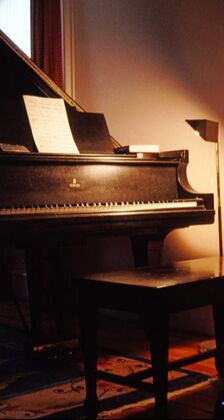 Last month I reviewed some technologies for online teaching. summer-thoughts-on-online-music-learning.html Since writing, Zoom’s September update (5.2.2) has greatly improved its sound quality for music-making. So I thought I would update you on results from testing the different options outlined in the first paper, and review the Zoom update. Last month, I recommended using two platforms together in lessons – Cleanfeed/iMidi for audio and Jitsi Meet for video[2]. I still consider these to be the best options but the picture is more nuanced now. I have tested each of these, plus the ‘hi-fi’ options in Zoom’s update, and identified other aspects of your set up that you may like to change to transmit better sound[3]. Please note that even if you update your Zoom client, you will not automatically get better sound, so this paper also covers the easy steps for setting up Original Sound in the new versions.
Methodology Excerpts of performances of same piece, selected for its range of register, dynamics and resources, were recorded during the early afternoon at a weekend. Three different microphones were used, three platforms (two with configuration options) and two different browsers were used. The device used was a Windows laptop with ethernet cable connection to the internet. Conclusions: Microphones and headphones The weak link in most people’s set up is the integral microphone in the device. Even most separate webcams have very basic microphones, designed for voice conferencing. I use a Q2N USB webcam with a mic designed for music. This retails at around £150, but even a £30-£40 mic is likely to be an improvement on what is in your phone. Please remember that a microphone, rather like a face covering, mostly benefits the person you are communicating with rather than yourself. To an extent, this is true of headphones as well. Headphones are worn to benefit the other person in the lesson, by cutting out echo and feedback for them, at least as much as they are used to deliver clear sound to your own ears. Just as for the microphone, any set of headphones is better than none, but bluetooth headphones may add to the 'lag' you experience. 1. Review of Zoom update 5.2.2. Zoom’s update to 5.2.2 has improved sound quality for music-making. To download Zoom, go to zoom.us and follow on-screen instructions If you previously downloaded Zoom before September this year, update to 5.2.2 by opening your zoom client on your device. Click your profile icon (top right), choose Check for Updates, and follow on-screen instructions. To update Audio, click the Settings gear (top right), choose Audio and Advanced. Keep Echo Cancellation at Auto and tick all other options. *Please note the warnings under the question marks – they mostly make the same point as I do in section 6 of this paper, ie connect by ethernet not wifi. 2. Trial results: Zoom with Cleanfeed This option uses Zoom for video only. See Section 4 for audio test results. 3. Trial results: Jitsi Meet on its own In summer lessons, pupils mostly reported slightly improved sound, but this was in comparison with the older version of Zoom. 4. Trial results: Cleanfeed (with either Jitsi Meet or Zoom for video) The set up and joining instructions took some getting used to, but I have now set up a unique link for every pupil. Cleanfeed performed well in tests, and all summer lesson pupils reported better sound. Cleanfeed is at its best when: There are ‘fixes’ available in Cleanfeed to repair the sound if headphones cannot be worn, but in some cases this appeared to reduce the sound to levels at or even below those of Jitsi and the latest version of Zoom. There is more video lag with Zoom, but screen sharing options and additional cameras are easier to set up. How much this matters to you will depend how helpful you find the Classroom Maestro keyboard demos, so please do complete the survey on this. 5. Trial results: Internet Midi Internet Midi sound is as good as your digital piano. Any variance in results from using different conferencing options will be reported on later. 6. Trial results: ethernet connection An ethernet connection will improve whichever options you choose, but is essential if you stay with Zoom. This is because Cleanfeed and Jitsi are 'peer to peer' connections, meaning that signals go directly between users. Zoom works by sending data in to a central server and out again. Packeting audio and video together will also contribute to lag and screen-freezes, and the upgraded ‘hifi’ sound is known to be heavy on bandwidth. Jitsi, Internet Midi and Cleanfeed are secure, in part because they are ‘ephemeral’ connections and so there are no 'rooms' to be hacked into. Passwords will be used for all platforms and students under 18 will connect and work under the supervision of a responsible adult. Bibliography As for the original paper, I draw here on the work done by Dr Ian Howells from the New England Conservatory of Music and additionally on work done by the European Piano Teachers’ Association (EPTA-UK). Ian Howell, June 2020, “Technology Enabled Music Lessons” https://www.ianhowellcountertenor.com/technology-enabled-music-lessons (accessed August 3, 2020) Cleanfeed Knowledge base, 2020, “Eliminating echo” https://cleanfeed.net/knowledge/eliminating-echo (accessed August 5, 2020) Timewarp Technologies, 2020, “Introduction to Internet Midi”, video tutorial https://timewarptech.com/introduction-to-internet-midi/?v=79cba1185463 Timewarp Technologies, 2020, “Using Internet Midi with Video Conferencing software”, video https://timewarptech.com/using-internet-midi-with-video-conferencing-software/?v=79cba1185463
0 Comments
Your comment will be posted after it is approved.
Leave a Reply. |
AuthorNews and thoughts from the piano bench Categories
All
Archives |

 RSS Feed
RSS Feed
